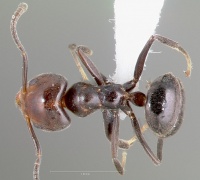Technomyrmex lujae
| Technomyrmex lujae | |
|---|---|

| |
| Scientific classification | |
| Kingdom: | Animalia |
| Phylum: | Arthropoda |
| Class: | Insecta |
| Order: | Hymenoptera |
| Family: | Formicidae |
| Subfamily: | Dolichoderinae |
| Genus: | Technomyrmex |
| Species: | T. lujae |
| Binomial name | |
| Technomyrmex lujae (Forel, 1905) | |
| Synonyms | |
| |
T. lujae may be locally extremely numerous. It is the “Technomyrmex 2” of Watt, Stork & Bolton (2002), the most abundant arboreal ant recorded from the canopies of Terminalia ivorensis trees in Mbalmayo Forest Reserve. Cameroun. (Bolton 2007)
Identification
Bolton (2007) - This stoutly built, size-variable, arboreal species is immediately recognisable by its combination of reduced palp formula, complete lack of dorsal setae, broadly emarginate clypeal margin, short scapes, very broad head upon which the small eyes are located relatively far forward, and highly placed propodeal spiracle. It has no obvious close relatives and is unlikely to be confused with any other species. The PF 4,3 is also found only in the Borneo species Technomyrmex reductus but apart from the palp formula the two are very different and have obviously independently evolved this feature.
Keys including this Species
Distribution
Latitudinal Distribution Pattern
Latitudinal Range: 7.385427° to -4.283333°.
| North Temperate |
North Subtropical |
Tropical | South Subtropical |
South Temperate |
- Source: AntMaps
Distribution based on Regional Taxon Lists
Afrotropical Region: Cameroun, Central African Republic, Democratic Republic of Congo (type locality), Gabon.
Distribution based on AntMaps
Distribution based on AntWeb specimens
Check data from AntWeb
Countries Occupied
| Number of countries occupied by this species based on AntWiki Regional Taxon Lists. In general, fewer countries occupied indicates a narrower range, while more countries indicates a more widespread species. |

|
Estimated Abundance
| Relative abundance based on number of AntMaps records per species (this species within the purple bar). Fewer records (to the left) indicates a less abundant/encountered species while more records (to the right) indicates more abundant/encountered species. |

|
Biology
Castes
Nomenclature
The following information is derived from Barry Bolton's Online Catalogue of the Ants of the World.
- lujae. Engramma lujae Forel, 1905b: 181 (w.m.) DEMOCRATIC REPUBLIC OF CONGO. Wheeler, G.C. & Wheeler, J. 1951: 194 (l.). Combination in Technomyrmex: Shattuck, 1992c: 161. Senior synonym of griseopubens, pulliceps, wasmanni; Bolton, 2007a: 26.
- wasmanni. Engramma lujae r. wasmanni Forel, 1916: 432 (w.q.m.) DEMOCRATIC REPUBLIC OF CONGO. Combination in Technomyrmex: Shattuck, 1992c: 161. Junior synonym of lujae: Bolton, 2007a: 26.
- griseopubens. Engramma griseopubens Wheeler, W.M. 1922a: 206, fig. 52 (w.) DEMOCRATIC REPUBLIC OF CONGO. Combination in Technomyrmex: Shattuck, 1992c: 160. Junior synonym of lujae: Bolton, 2007a: 26.
- pulliceps. Engramma lujae var. pulliceps Santschi, 1926b: 244 (w.) DEMOCRATIC REPUBLIC OF CONGO. Combination in Technomyrmex: Shattuck, 1992c: 161. Junior synonym of lujae: Bolton, 2007a: 26.
Unless otherwise noted the text for the remainder of this section is reported from the publication that includes the original description.
Description
Worker
Bolton (2007) - TL 2.7 - 3.7, HL 0.72 - 0.86, HW 0.74 - 0.95, SL 0.54 - 0.64, PW 0.48 - 0.58, WL 0.84 - 0.98 (15 measured). Indices: CI 100 - 110, SI 67 - 76, OI 17 - 21, EPI 46 - 54, DTI 100 - 110.
Palp formula 4,3. Dorsum of head posterior to c1ypeus entirely lacks setae. Head in full-face view relatively very broad (CI 100 or more). Clypeus with a broad, conspicuous median emargination that is approximately semicircular and forms a wide notch; inner margin of notch meets anterIor clypeal margin in an angle on each side. Posterior margin of head broadly emarginate; sides of head convex and convergent anteriorly. Eyes relatively small (OI < 25) and located far forward (EPI < 60), their outer margins are far from the sides of the head in full-face view and conspicuously fail to break the outline of the sides. Scape short (SI < 85). Mesosoma entirely lacks setae and is short and compact; mesonotum convex in profile; metanotal, groove narrow but impressed, abutted by the metathoracic spiracles, Propodeal dorsum in profile shallowly sloping posteriorly; propodeal spiracle high, located adjacent to the point where the slope of the dorsum curves into the declivity rather than half or more the distance down the declivity. Gastral tergites 1 - 4 entirely lack setae; a few are present on the gastral sternites, projecting ventrally. Scapes and legs without setae. Colour variable, from uniform light brown to blackish brown, often with the head lighter in shade than the body. In darkly coloured samples the head may be reddish brown to dull red and contrast with the darker body. Legs the same colour as the mesosoma throughout.
Type Material
Bolton (2007) - Syntype workers and males. Democratic Republic of Congo: Kasai, Kondue (Luja) (Musee d'Histoire Naturelle Genève) [examined].
References
- Bolton, B. 2007b. Taxonomy of the dolichoderine ant genus Technomyrmex Mayr (Hymenoptera: Formicidae) based on the worker caste. Contributions of the American Entomological Institute. 35(1): 1-149.
- Forel, A. 1905e. Miscellanea myrmécologiques II (1905). Ann. Soc. Entomol. Belg. 49: 155-185 (page 181, worker, male described)
- Shattuck, S. O. 1992c. Generic revision of the ant subfamily Dolichoderinae (Hymenoptera: Formicidae). Sociobiology 21: 1-181 (page 161, Combination in Technomyrmex)
- Wheeler, G. C.; Wheeler, J. 1951. The ant larvae of the subfamily Dolichoderinae. Proc. Entomol. Soc. Wash. 53: 169-210 (page 194, larva described)
References based on Global Ant Biodiversity Informatics
- Baroni Urbani C. 1977. Katalog der Typen von Formicidae (Hymenoptera) der Sammlung des Naturhistorischen Museums Basel (2. Teil). Mitt. Entomol. Ges. Basel (n.s.) 27: 61-102.
- Bolton B. 2007. Taxonomy of the dolichoderine ant genus Technomyrmex Mayr (Hymenoptera: Formicidae) based on the worker caste. Contributions of the American Entomological Institute 35(1): 1-150.
- Bolton, B. "Taxonomy of the dolichoderine ant genus Technomyrmex Mayr (Hymenoptera: Formicidae) based on the worker caste." Contributions of the American Entomological Institute 35, no. 1 (2007): 1-149.

